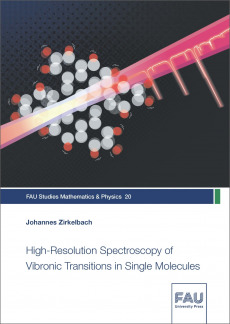Johannes Zirkelbach
High-Resolution Spectroscopy of Vibronic Transitions in Single Molecules
Reihe: FAU Studies Mathematics & PhysicsDye molecules in organic crystals are excellent single-photon sources and can act as non-linear elements in optical circuits. Since these molecules lack a long-lived spin state, they have previously not been considered for applications that require a quantum memory. In principle, the vibrational modes of single dye molecules in organic crystals could serve that purpose and act as qubits. Due to their coupling to the crystal lattice, the lifetimes of molecular vibrations are often limited to around 10 ps. In the field of cryogenic single molecule spectroscopy, however, the decay constants of vibrational modes have never been studied systematically. This leaves open the possibility that some modes exhibit considerably longer lifetimes.
In this work, we study the linewidths of vibrational modes of single dibenzoterrylene (DBT) molecules in paradichlorobenzene (pDCB) and anthracene (AC) crystals at cryogenic temperatures using their vibronic spectra. To identify long-lived modes, these spectra are measured at a high spectral resolution via fluorescence excitation spectroscopy and stimulated emission depletion (STED) spectroscopy with narrowband tunable lasers. We show that the linewidths of some vibrational modes of DBT in pDCB reach values around 2 GHz. This corresponds to a lifetime of 80 ps and is, thus, significantly longer than the typical lifetimes of vibrational modes in the solid state.
We also observe indications of the coherent excitation of a vibronic mode in the electronic ground state of DBT in pDCB. The associated splitting of the absorption profile of a vibronic transition is achieved by tuning an intense control laser on resonance with a transition between two vibronic states with a high Franck-Condon overlap. According to our model calculation, 80 %% of the population that is transferred to the vibronic state of the electronic ground state is coherent in this process. If the vibrational lifetimes of certain modes can be extended by decoupling them from crystal phonons, similar schemes may be exploited in future for the coherent transfer of a flying qubit state to a vibrational state of a single molecule.
Farbstoffmoleküle in organischen Kristallen sind hervorragende Einzelphotonen-Quellen und können als nicht-lineare Elemente in optischen Schaltkreisen genutzt werden. Weil ihnen ein langlebiger Spin-Zustand fehlt, wurden diese Moleküle bisher jedoch nicht als Speicher für Quanteninformation in Betracht gezogen. Im Prinzip könnten anstatt von Spinzuständen die Schwingungsmoden einzelner Farbstoffmoleküle in organischen Kristallen als Quantenbits genutzt werden. Die Lebensdauer dieser Molekülschwingungen ist jedoch durch ihre Kopplung an das Kristall-Gitter oftmals auf etwa 10 ps beschränkt. In der kryogenen Einzelmolekülspektroskopie wurden die Lebensdauern der Molekülschwingungen allerdings bisher in keiner einzigen Molekül-Matrix-Kombination systematisch gemessen, so dass es einzelne Moden mit deutlich längeren Lebensdauern geben könnte.
In dieser Arbeit werden die Linienbreiten der Schwingungsmoden einzelner Dibenzoterrylen (DBT) Moleküle in Paradichlorbenzol- (pDCB) und Antracen-Kristallen bei kryogenen Temperaturen anhand vibronischer Spektren untersucht. Dabei wird durch Fluoreszenz-Anregungsspektroskopie und STED-Spektroskopie mit schmalbandigen, durchstimmbaren Lasern eine hohe spektrale Auflösung erreicht. Wir zeigen, dass die Linienbreiten einiger Schwingungsmoden von DBT Molekülen in pDCB Werte von 2 GHz erreichen. Dies entspricht einer Schwingungslebensdauer von 80 ps und liegt somit weit über den typischen Relaxationszeiten in organischen Kristallen.
In einem weiteren Experiment beobachten wir Anzeichen dafür, dass eine Schwingungsmode im elektronischen Grundzustand von DBT trotz ihrer kurzen Lebenszeit in pDCB kohärent angeregt werden kann. Die damit einher gehende Aufspaltung eines vibronischen Übergangs wird erreicht, indem ein Kontroll-Laser in Resonanz mit einem Übergang zwischen zwei vibronischen Zuständen mit hohem Franck-Condon-Faktor gebracht wird. Laut unseren Modellrechnungen ist die Population, die in dieser experimentellen Konfiguration in den unteren vibronischen Zustand übertragen wird, zu 80 %% kohärent. Wenn in Zukunft langlebige Schwingungsmoden realisiert werden, könnte man ähnliche Ansätze nutzen, um fliegende Quantenzustände kohärent in Schwingungszustände eines Moleküls zu überführen und dort zu speichern.

